One reason that communication is pretty wonderful: you can do it anywhere, at any time. You can do it lying down. You can do it as a clown. You can chat with mom and Dad. You can fight evil, and not be sad. Communication is like the best all - cotton undergarment; it fits all, it's extremely comfortable,and no one can come by and snap your strap. It is yours. No one had better say you cannot communicate. "I got this", as the young people say.
I therefore often tell persons I serve, that the best way to improve your communication is to communicate. I know why this might be the best solution for some persons served: they see the predicament that brought them to my attention, as occurring in real life. They want to practice things that they will do in real life...."I'm never going to do that! 'Name 5 brands of laundry detergent you see advertised on TV' " (perplexed scowl accompanying)....
That person may tell you instead, that she/he knows she will be functioning better - when her daughter drops in unexpectedly from college with a week's worth of laundry, and needs it in 24 hours. Her post concussion syndrome would initially have capsized any attempt to run her household. But, following practice of the activity in the house that eliminated any concern for the component skills constituting 'doing laundry', this person served rocks the house with laundry.
Though this person served may have occasional feelings of "Now WHAT am I doing?", or momentarily forget to add the fabric softener when the phone rings, - or that she needs a rest between loads - she gets her laundry done. Yes, SLP does laundry. But- what if the performance of the person served breaks down during the marathon washing for collegian daughter??
Perhaps she needs the washing marathon broken down during treatment, to work on the wash cycle in isolation: the sequence of sorting, pre-treating, loading, adding detergent, setting cycle, starting, adding fabric softener, then transferring spun clothing to either the dryer or hanging them to air-dry. The series of actions are organized and strung together: the inventory of materials needed, sufficient quantity of each, the spaces in the laundry area that must be maneuvered, the time intervals involved, and strict control of environmental distractions (e.g. persons observing, entertainment played in the background, animals walking through the wash area), help the person served not be sad about the wash cycle. I know why the training of this activity works, given the focus supplied. Less variables to control, a more "clinical" environment to make paying attention to tasks easier, and multi-modal sensory feedback to give the person served oodles of clues.
There are still other persons served that would find - that they continue to demonstrate impairments of bodily function. The laundry scenario may then be disassembled even more. so the various cognitive-communicative component skills that support each step in the sequences WASH, DRY, FOLD - (non)verbal memory, attention, or expressive language to name just a few - could be strengthened to a degree that laundry is made new again! "When you think of laundry detergents you can buy in the store, you think of ....?". I know why impairment-based training is essential, relevant and effective for a cohort we serve. The satisfaction of serving persons who find themselves struggling to connect with the world is bottomless.
I know why the work of professionals in speech-language pathology is so wonderful. I get this.






No comments:
Post a Comment